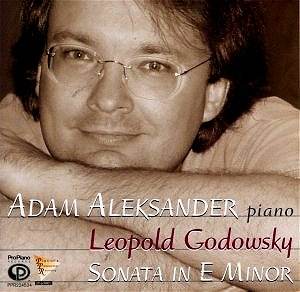Godowsky (real name 'Passinock') was born in Poland.
Despite his father's best laid plans for his son to become another Paganini
young Leopold showed a phenomenal gift for the piano. When only fourteen
he made a concert tour of the USA (1884-86). From 1895 to 1900 he headed
the Chicago Conservatory's piano department. On 6 December 1900 in Berlin
he took Europe by storm and was soon appointed Director, piano school,
Vienna Imperial Academy of Music. The Great War drove him back to the
USA where he settled permanently apart from a hectic round of world
tours one of which drew from him the exotic Java Suite (taken
by Esther Budiardjo on ProPiano PPR224529). In 1930 a stroke during
a London recording session put paid to his public career. He lived on
another eight years spared the knowledge of yet another murderous tragedy
scarring his homeland.
At two minutes over three quarters of an hour Godowsky
surely intended this sonata to be a significant contribution to the
literature. It was largely written in the Swiss town of Beatenberg near
Interlaken and premiered by the composer on 28 January 1911 in Berlin.
The dedication is to his "dear wife" as befits a work of such noble
passion and lyricism.
The outer two of the five movements attain just short
of a quarter of an hour playing time. They are profusely luxuriant with
liana tendrils of melody. The first is marked Allegro no troppo ma
appassionato which is exactly as it sounds in Adam Aleksander's
hands. The music is subtle, noble, and at times shows the most tender
touches - music we associate with Rachmaninov (e.g. 4.10 and 12.11)
or Medtner (Sonata Romantica - a work in prospect at that time
rather than already written). Similarly tender melodic invention threads
through the final movement - at 3.24. A nostalgic and touchingly romantic
Andante cantabile steers just the right side of Macdowell's sentimentality.
The elfin heroics of the allegretto vivace e scherzando flit
and flicker gravely like a stern Mendelssohn's Midsummer Night's
Dream. The allegretto grazioso e dolce betrays his Viennese
residency with the waltz archly smiling its way through these pages.
In the finale there is a notable 'Night Watch' ‘marche militaire’ (8.02)
through which threads shades of the Dies Irae. After melting
into a milky moonlight glow the nocturnal march returns and fades into
the same confidently subtle almost Debussian glow.
This is an impressive piece allowing for passing doubts
about the place of the wonderfully Bachian three-part fugue in the finale.
Godowsky's memory is extremely well served by Adam Aleksander who is
a pupil of Sergei Babayan, Regina Smendzianka, Jim Bonn and Ivan Davis.
You are never in any doubt that Aleksander believes in this music.
Kathy Henkel contributes the well thought through notes.
The sonata is played using a Hamburg Steinway D 0180
and is warmly and very pleasingly recorded.
Rob Barnett

